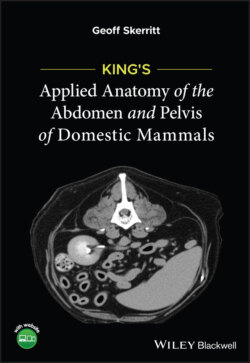Читать книгу King's Applied Anatomy of the Abdomen and Pelvis of Domestic Mammals - Geoff Skerritt - Страница 40
2.2.4 Absorption
ОглавлениеFollowing the physical and chemical treatment of the food and the breakdown of the major constituents into simple sugars, amino acids, fatty acids, etc., these relatively simple substances are absorbed by the columnar cells that line the small intestines and, to a lesser extent, the large intestines.
To facilitate absorption, and to increase the available surface area for absorption, various adaptations characterise the small intestines. The following are of particular significance: (i) in most mammalian species the small intestine is extremely long, as much as many times the length of the body. To accommodate this within the abdominal cavity, the small intestine is extensively coiled and is suspended as festoons by the peritoneal sheets of the mesentery. (ii) Crescentic folds of the internal lining membrane (the mucous membrane) occur, known as the plicae circulares (or the valves of Kerkring). (iii) Tiny finger‐like projections of the lining mucous membrane are present in vast numbers along the length of the small intestine. They are covered by absorptive and mucus‐secreting cells, and with a core of connective tissue, smooth muscle cells, blood vessels and lacteals, channels for transport of fat. These minute projections, known as villi, enormously increase the area for absorption. (iv) Finally, at the cellular level, at the luminal surface of each absorptive cell, the cell membrane is itself thrown into submicroscopic projections known as microvilli, which further increase the available absorptive surface.
